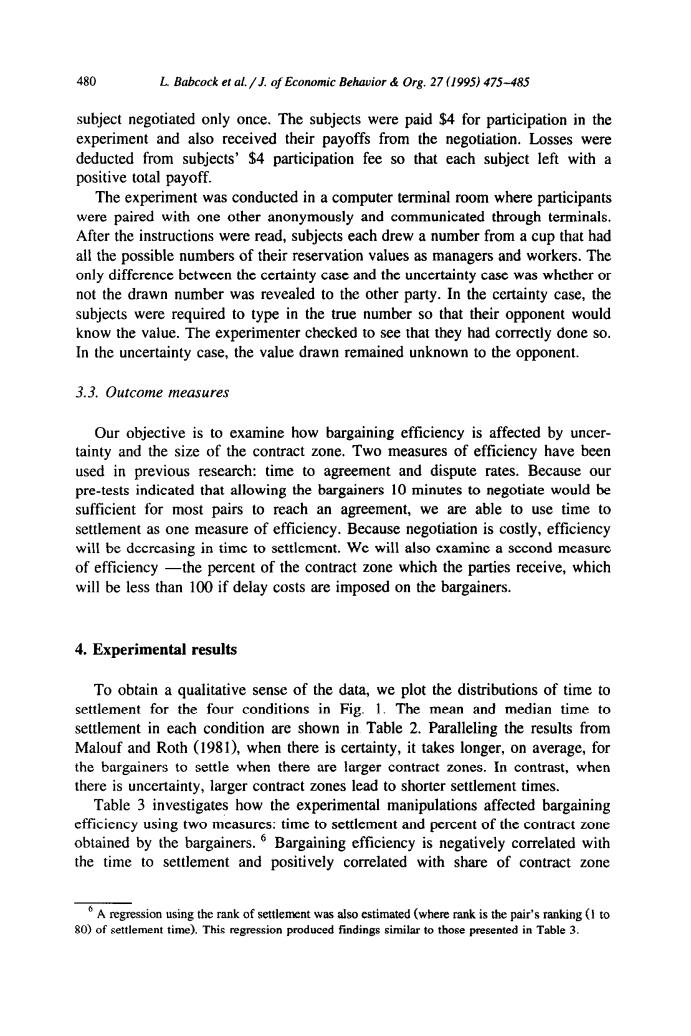正在加载图片...

L Babcock et al./J.of Economic Behavior Org.27 (1995)475-485 subject negotiated only once.The subjects were paid $4 for participation in the experiment and also received their payoffs from the negotiation.Losses were from subje c s'$4 participation fee so that each subject left with a positive total payoff The experiment was conducted in a computer terminal room where participants were paired with one other anonymously and communicated through terminals After the instructions were read,subjects each drew a number from a cup that had all the possible numbers of their reservation values as managers and workers.The only difference between the certainty case and the uncertainty case was whcther or not the drawn number was revealed to the other party.In the certainty case,the subjects were required to type in the true number so that their opponent would know the value.The experimenter checked to see that they had correctly done so. In the uncertainty case,the value drawn remained unknown to the opponent. 3.3.Outcome measures Our objective is to examine how bargaining efficiency is affected by uncer tainty and the size of the contract zone.Two measures of efficiency have been used in previous research:time to agreement and dispute rates.Because our pre-tests indicated that allowing the bargainers 10 minutes to negotiate would be sufficient for most pairs to reach an agreement,we are able to use time to me tas one measure of efficiency egotiat ion is costly,efficiency will be dccrcasing in time to settlement.We will also cxamine a sccond measure of efficiency -the percent of the contract zone which the parties receive,which will be less than 100 if delay costs are imposed on the bargainers. 4.Experimental results To obtain a qualitative sense of the data,we plot the distributions of time to settlement for the four conditions in Fig.1.The mean and median time to settlement in each condition are shown in Table 2.Paralleling the results from Malouf and Roth(1981),when there is certainty,it takes longer,on average,for the bargai ners ettle ther are 20 In when there is uncertainty,larger con tract zones lea d to shorter nt ames Table 3 investigates how the experimental manipulations affected bargaining efficiency using two mcasures:time to settlement and percent of the contract zone obtained by the bargainers.6 Bargaining efficiency is negatively correlated with the time to settlement and positively correlated with share of contract zone A regression using the rank of settlement was also estimated (where rank is the pair's ranking(I to 80)of time)This produced findings similar to those presented in Table 3.480 L. Babcock et al. /J. of Economic Behavior & Org. 27 (199.5) 475-485 subject negotiated only once. The subjects were paid $4 for participation in the experiment and also received their payoffs from the negotiation. Losses were deducted from subjects’ $4 participation fee so that each subject left with a positive total payoff. The experiment was conducted in a computer terminal room where participants were paired with one other anonymously and communicated through terminals. After the instructions were read, subjects each drew a number from a cup that had all the possible numbers of their reservation values as managers and workers. The only difference between the certainty case and the uncertainty case was whether or not the drawn number was revealed to the other party. In the certainty case, the subjects were required to type in the true number so that their opponent would know the value. The experimenter checked to see that they had correctly done so. In the uncertainty case, the value drawn remained unknown to the opponent. 3.3. Outcome measures Our objective is to examine how bargaining efficiency is affected by uncertainty and the size of the contract zone. Two measures of efficiency have been used in previous research: time to agreement and dispute rates. Because our pre-tests indicated that allowing the bargainers 10 minutes to negotiate would be sufficient for most pairs to reach an agreement, we are able to use time to settlement as one measure of efficiency. Because negotiation is costly, efficiency will be decreasing in time to settlement. We will also examine a second measure of efficiency -the percent of the contract zone which the parties receive, which will be less than 100 if delay costs are imposed on the bargainers. 4. Experimental results To obtain a qualitative sense of the data, we plot the distributions of time to settlement for the four conditions in Fig. 1. The mean and median time to settlement in each condition are shown in Table 2. Paralleling the results from Malouf and Roth (19811, when there is certainty, it takes longer, on average, for the bargainers to settle when there are larger contract zones. In contrast, when there is uncertainty, larger contract zones lead to shorter settlement times. Table 3 investigates how the experimental manipulations affected bargaining efficiency using two measures: time to settlement and percent of the contract zone obtained by the bargainers. 6 Bargaining efficiency is negatively correlated with the time to settlement and positively correlated with share of contract zone ’ A regression using the rank of settlement was also estimated (where rank is the pair’s ranking (1 to 80) of settlement time). This regression produced findings similar to those presented in Table 3